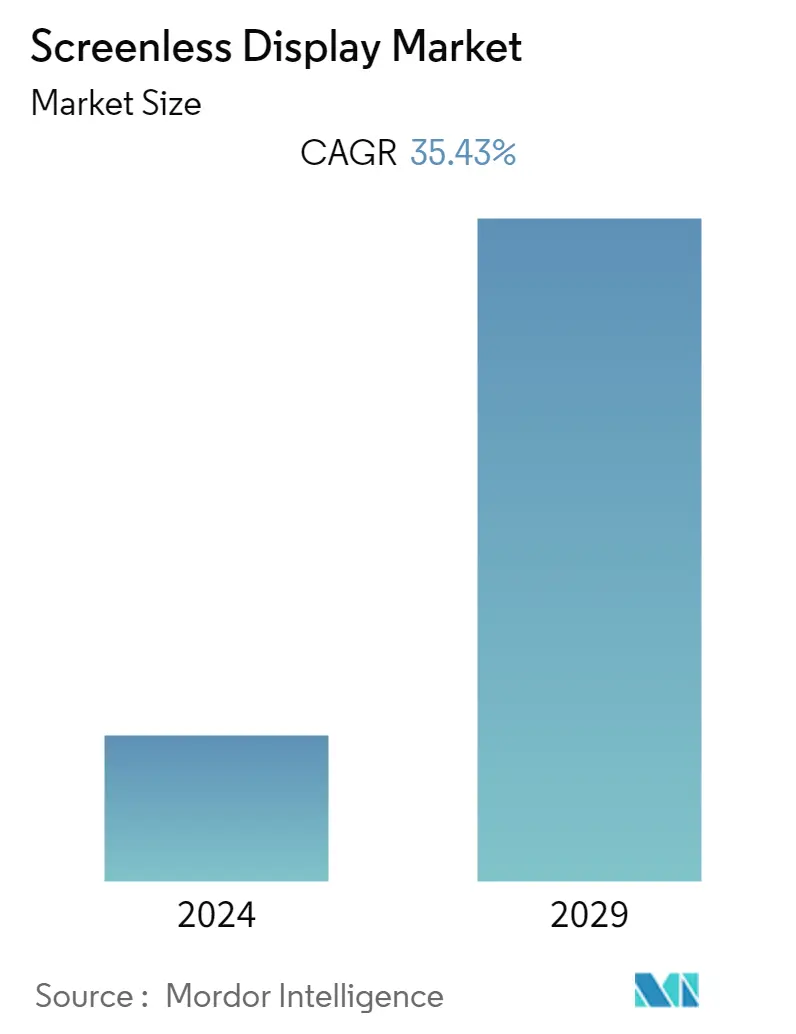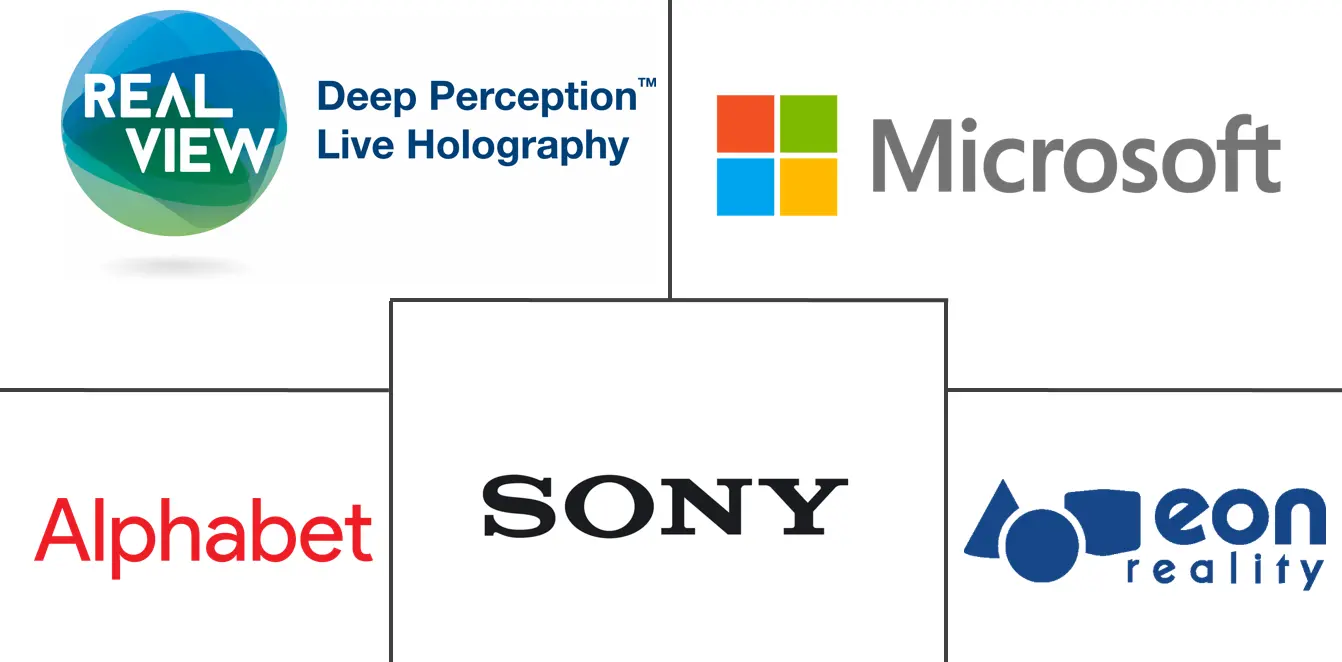Market Size of Screenless Display Industry

| Study Period | 2019 - 2029 |
| Base Year For Estimation | 2023 |
| CAGR | 35.43 % |
| Fastest Growing Market | Asia Pacific |
| Largest Market | North America |
| Market Concentration | High |
Major Players
*Disclaimer: Major Players sorted in no particular order |
Screenless Display Market Analysis
The screenless display market was valued at USD 932.57 million in 2020 and expected to reach a value of USD 5,758.89 million by 2026, at a CAGR of 35.43% during the forecast period (2021 - 2026). Screenless display is the advanced display technology, which replaces the touch screen technology to resolve the problems Screenless display projects the visual information utilizing a ricochet of light such as mirrors, plastic films, and fog. Currently, research is being done to extract information if air can be used to show the data. The introduction of this technology solves the problem for display space, owing to its portability at practically any place provided with enough circumference. The usage of the screenless display is expected to address the glitches associated with security and privacy and mitigate the probability of error, thereby propelling the industry.
- Nowadays, companies are actively using the AR service to boost brand awareness and marketing impacts, catering to future trends. According to Morgan Stanley, the estimated revenue from AR devices and its services are USD 118 billion and USD 68 billion, respectively, in 2020. This AR technique is being used by renowned brands to provide customers with a virtual representation of their products and enhance their purchase process through a holographic display.
- Vendors in the market are focused on leveraging the demand by announcing an improved product line with features including better resolutions and ease of use, among others. For instance, In November 2019, Holoxica Limited launched its 8k Holographic Display intending to provide companies with a way to view 3D assets as holograms, without the need to use VR headsets.
- In July 2019, a visual technology company HYPERVSN built the world's first 3D holographic display system. A lightweight, easy-to-install combination of hardware and software, the system brings ideas, concepts, and products to fantastical, surprising life. HYPERVSN has been used to create a variety of experiences for companies and events, including a Nike product launch in Seoul, an installation for Louis Vuitton at Selfridges, and a Hennessy event at Roland Garros.
- Further, Virtual reality goggles are shaping the retail industry by providing a rich customer experience through real-time product checks and reviews. It is anticipated to propel the market growth in the retail sector. In May 2020, HP announced the HP Reverb G2 virtual reality headset with high-resolution specs the company hopes would attract new enterprise users and consumers. The company is launching the second-generation VR headset in a partnership with both Microsoft and game company Valve. The headset will debut in the fall of USD 600.
- Companies in the Screenless Display market are taking suggestive steps to tackle the challenges resulting from the COVID-19 (Coronavirus) pandemic. However, the global shipments of Augmented Reality (AR) and Virtual Reality (VR) headsets are expected to decline in the first half of 2020 due to supply chain disruptions caused by the COVID-19 outbreak. The worldwide quarterly Augmented and Virtual Reality Headset Tracker, a year-over-year decline of 10.5%, is expected in the first quarter, followed by a 24.1% decline in the second quarter. However, assuming production ramps back up by midyear, it may rebound in the second half of 2020, which may result in total shipments of nearly 7.1 million units for the year, up 23.6% from 2019.
Screenless Display Industry Segmentation
The visual image is a type of screenless display that recognizes any image or thing with the help of the human eye. The following are a few examples of the visual image display: holographic display, virtual reality goggles, heads-up displays, etc. Retina display, instead of using some intermediate object for light reflection to project the images, directly projects the image onto the retina. The synaptic interface means sending information directly to the human brain without using any light. This technology is already tested on humans, and most of the companies started using this technology for effective communication, education, business, and security systems. In the report scope, the existing technology provider landscape also covered, which consists of major players operating in the market. The study also focuses on the impact of COVID-19 on the market ecosystem.
| Technology | |
| Visual Image | |
| Retina | |
| Synaptic Interface |
| End-user Industry | |
| Consumer Electronics | |
| Aerospace & Defense | |
| Healthcare | |
| Automotive | |
| Other End-user Industries |
| Geography | |
| North America | |
| Europe | |
| Asia-Pacific | |
| Latin America | |
| Middle East & Africa |
Screenless Display Market Size Summary
The screenless display market is poised for significant growth, driven by advancements in display technologies that eliminate the need for traditional screens. This innovative technology utilizes light projection methods, such as mirrors and fog, to display visual information, offering solutions to space constraints and enhancing portability. The market is experiencing increased interest due to its potential to address security and privacy concerns associated with conventional displays. Companies are leveraging augmented reality (AR) services to enhance brand visibility and customer engagement, with major brands adopting holographic displays to improve the purchasing experience. The introduction of products like Holoxica's 8k Holographic Display and HYPERVSN's 3D holographic display system highlights the industry's focus on improving resolution and user-friendliness. Despite challenges posed by the COVID-19 pandemic, the market is expected to rebound as production resumes, with virtual reality (VR) technology continuing to shape sectors like retail by offering immersive customer experiences.
North America leads the screenless display market, supported by a robust presence of technology firms and favorable government regulations promoting automotive innovations. The region's consumers, known for their early adoption of new technologies, contribute to the market's growth through increased spending on advanced gadgets. The market is characterized by a few dominant players, with product innovation being a key strategy for gaining competitive advantage. Recent developments include Bosch's AR smart glasses and Facebook's portal devices, showcasing the ongoing efforts to integrate screenless display technology into everyday products. The industry's expansion is further supported by research initiatives in institutions like MIT and the University of Washington, which are exploring new applications and enhancements in screenless display technologies.
Screenless Display Market Size - Table of Contents
-
1. MARKET DYNAMICS
-
1.1 Market Overview
-
1.2 Industry Value Chain Analysis
-
1.3 Market Drivers
-
1.4 Market Restraints
-
1.5 Industry Attractiveness - Porter's Five Forces Analysis
-
1.5.1 Threat of New Entrants
-
1.5.2 Bargaining Power of Buyers/Consumers
-
1.5.3 Bargaining Power of Suppliers
-
1.5.4 Threat of Substitute Products
-
1.5.5 Intensity of Competitive Rivalry
-
-
1.6 Assessment of COVID-19 on the Industry
-
-
2. MARKET SEGMENTATION
-
2.1 Technology
-
2.1.1 Visual Image
-
2.1.2 Retina
-
2.1.3 Synaptic Interface
-
-
2.2 End-user Industry
-
2.2.1 Consumer Electronics
-
2.2.2 Aerospace & Defense
-
2.2.3 Healthcare
-
2.2.4 Automotive
-
2.2.5 Other End-user Industries
-
-
2.3 Geography
-
2.3.1 North America
-
2.3.2 Europe
-
2.3.3 Asia-Pacific
-
2.3.4 Latin America
-
2.3.5 Middle East & Africa
-
-
Screenless Display Market Size FAQs
What is the current Screenless Display Market size?
The Screenless Display Market is projected to register a CAGR of 35.43% during the forecast period (2024-2029)
Who are the key players in Screenless Display Market?
Alphabet Inc., Eon Reality Inc., Sony Corporation, Microsoft Corporation and Realview Imaging Ltd. are the major companies operating in the Screenless Display Market.

